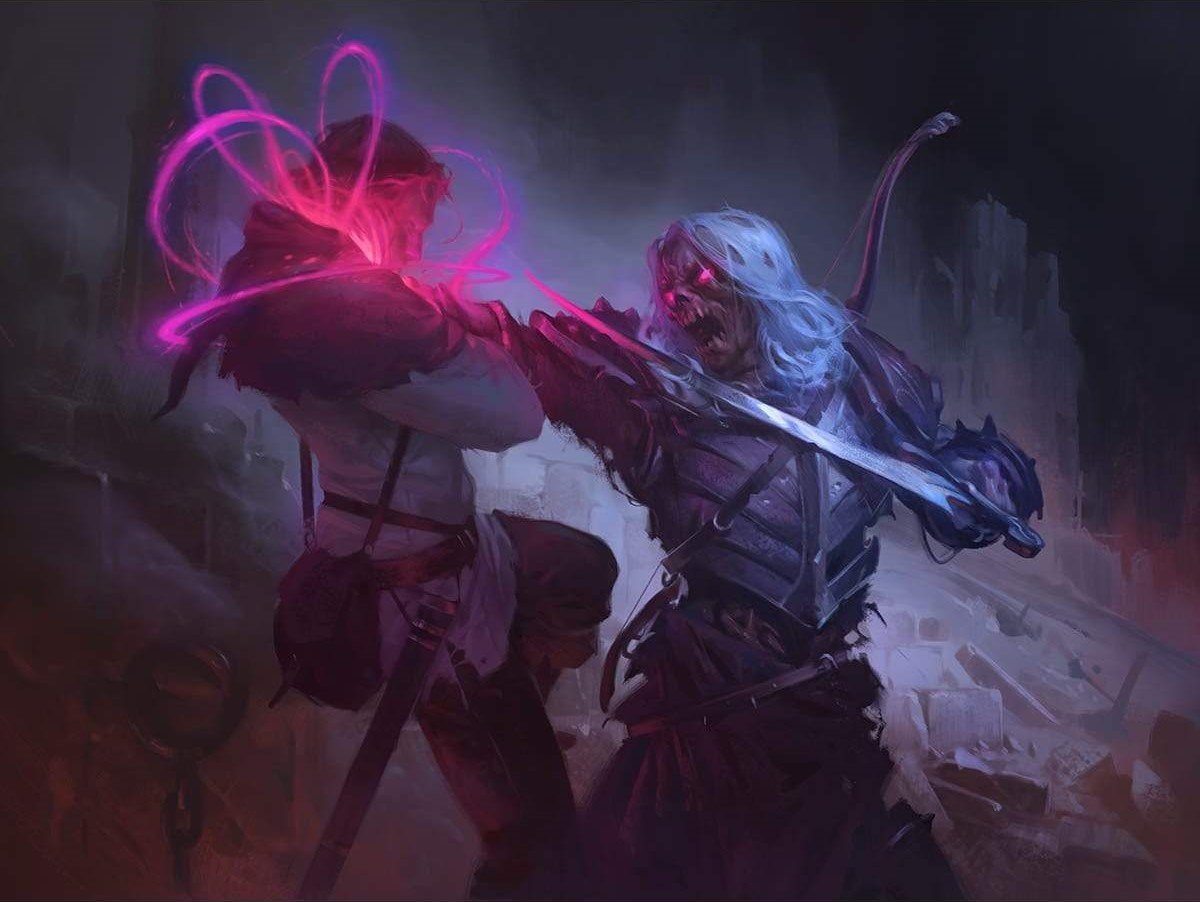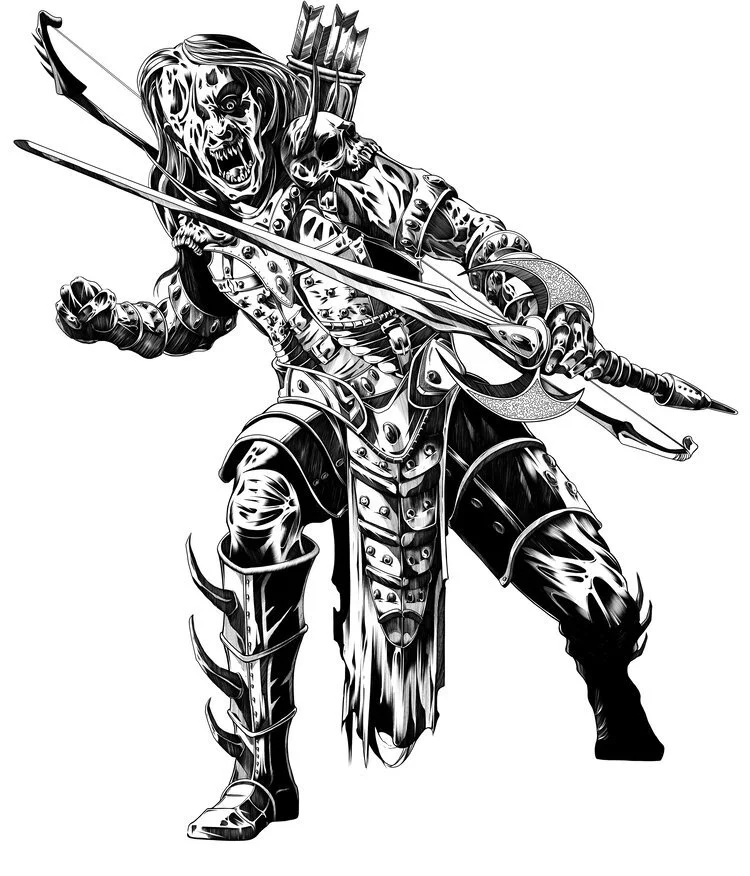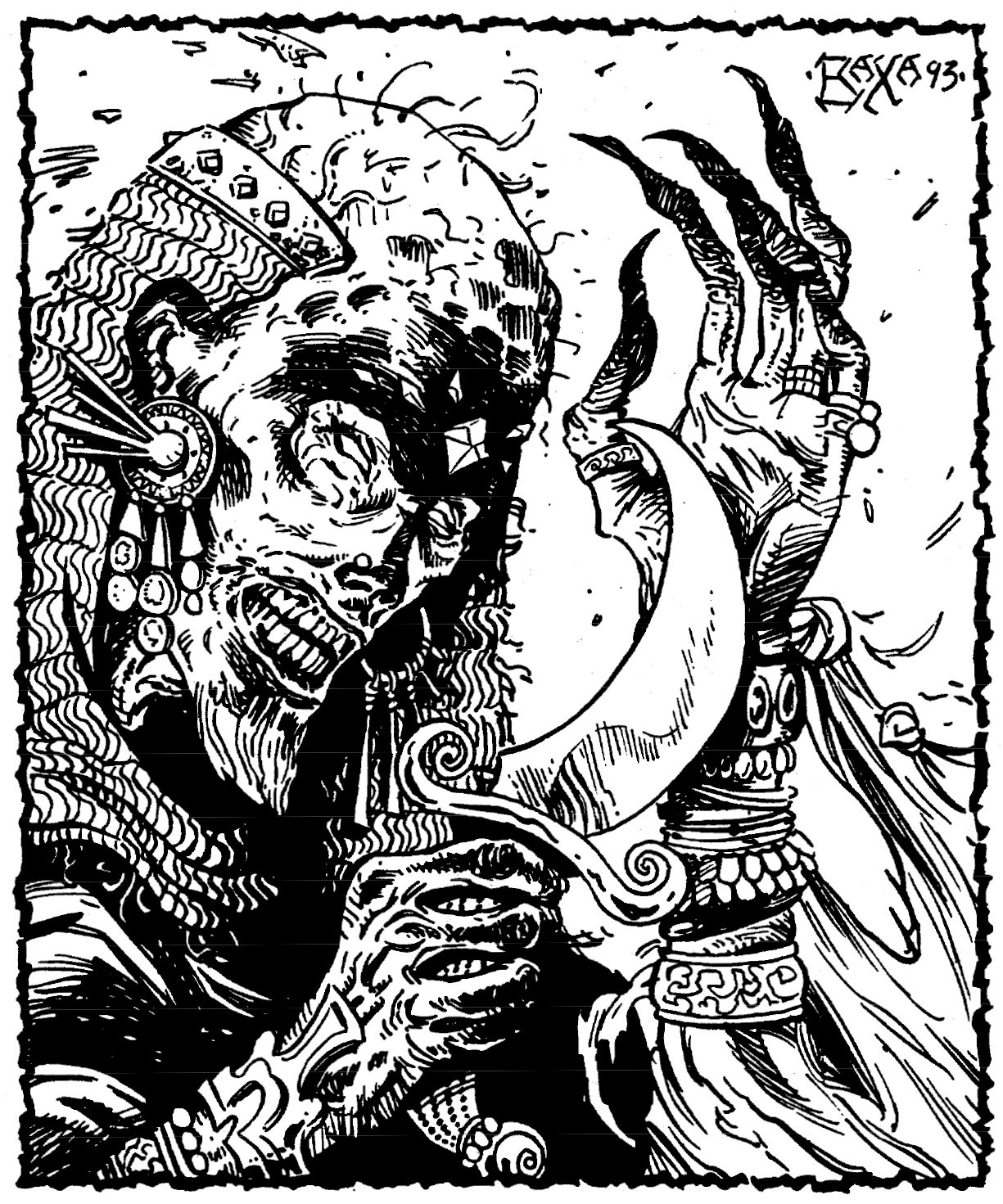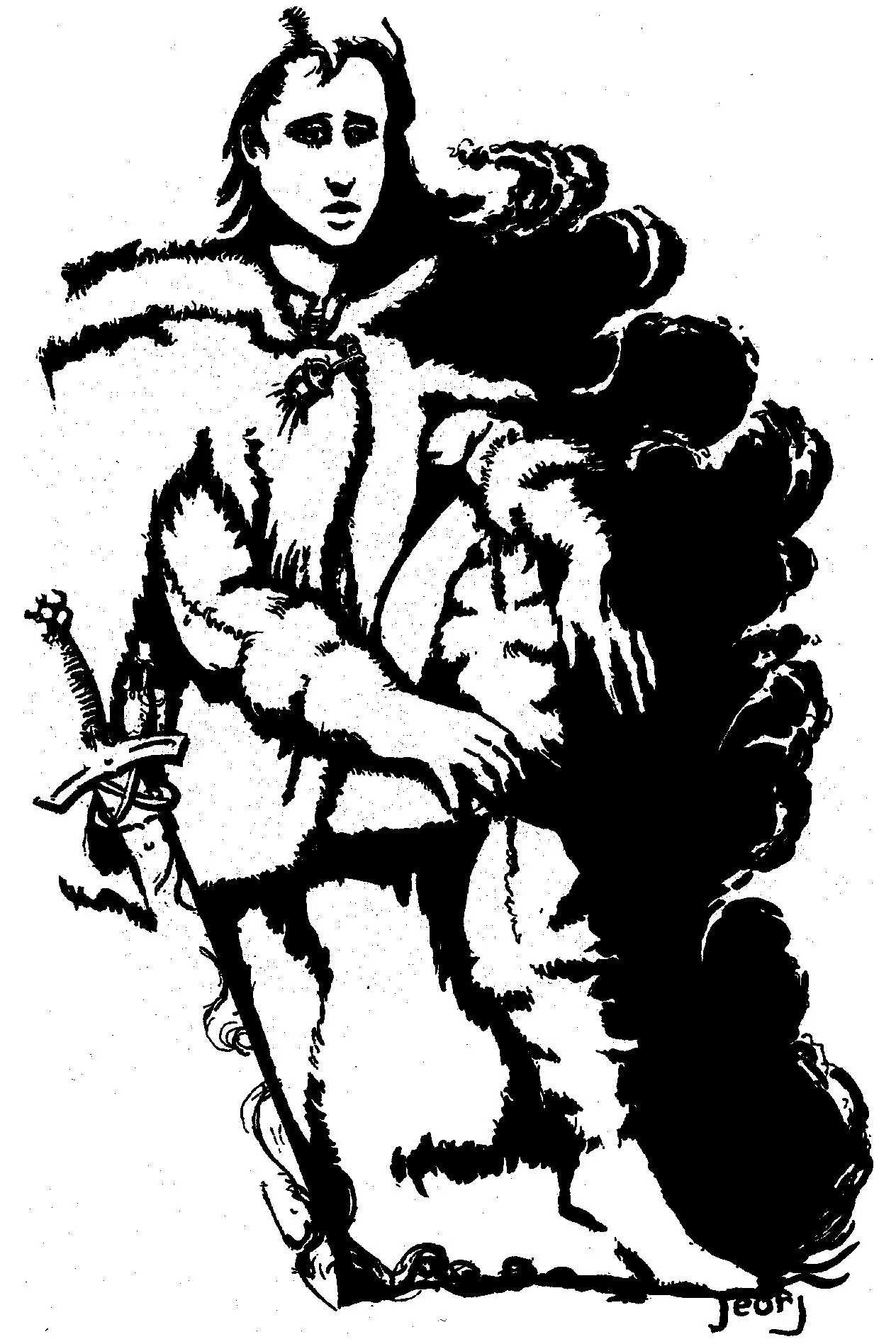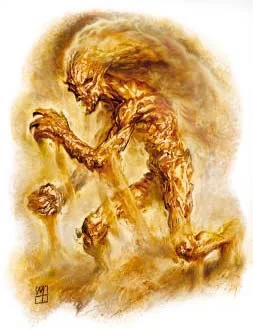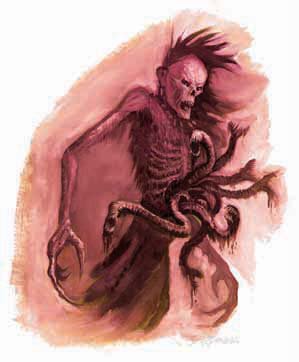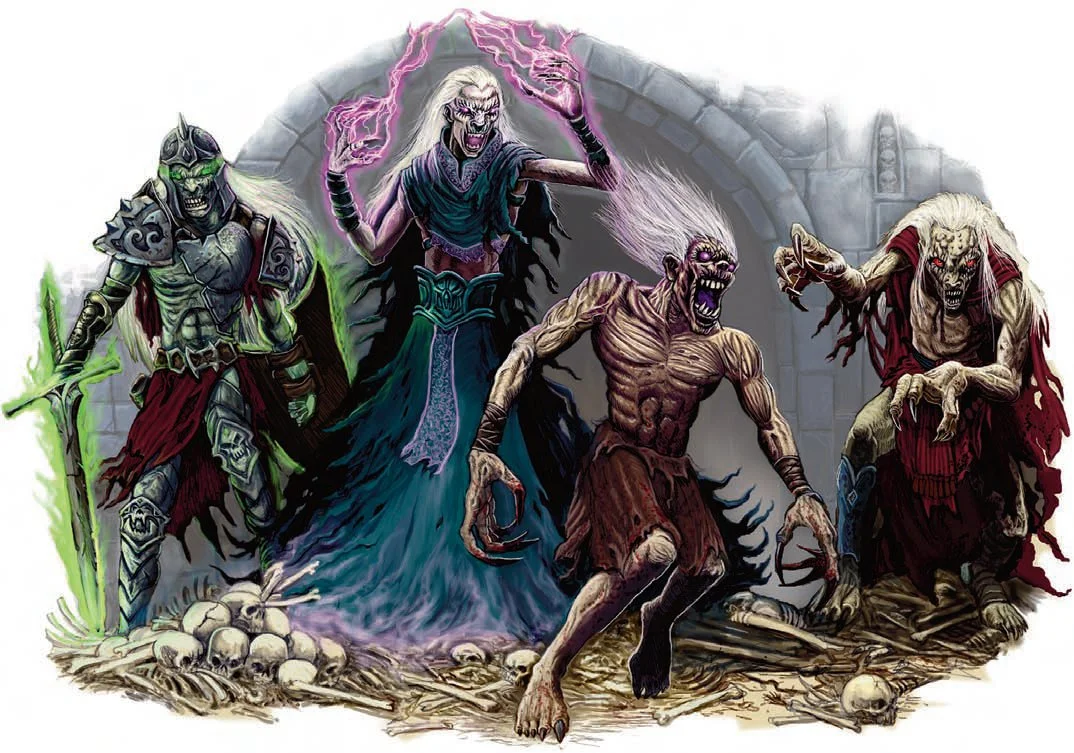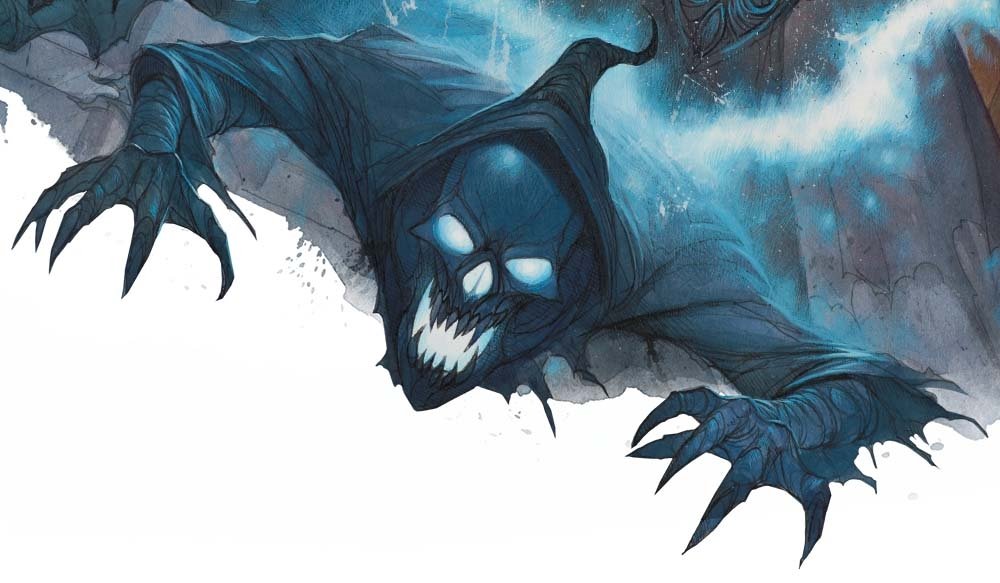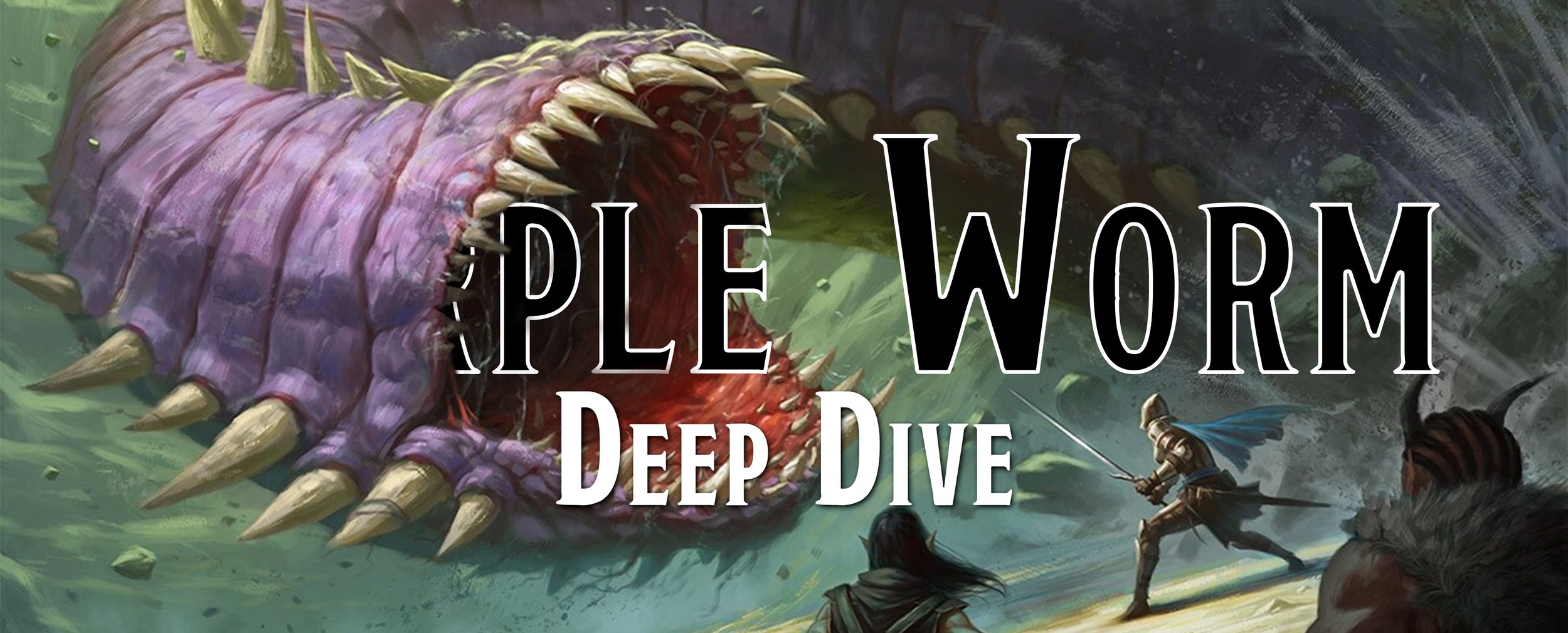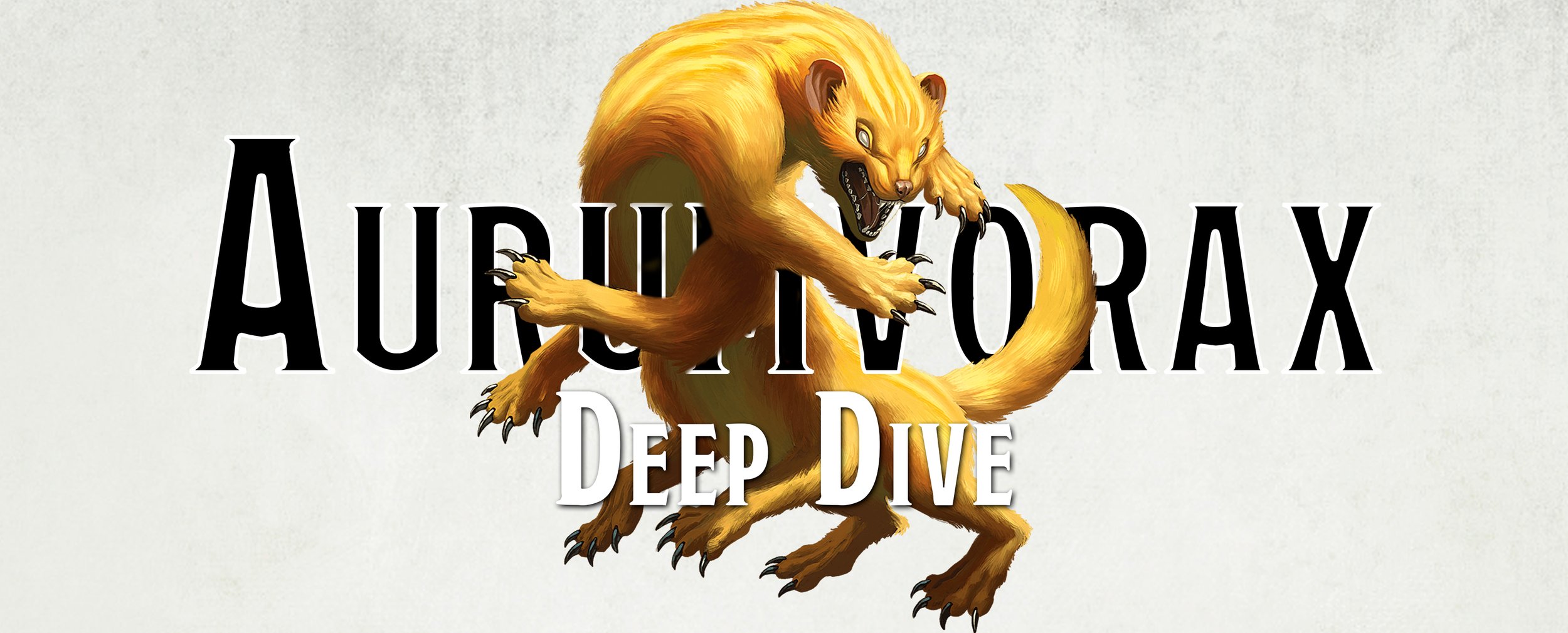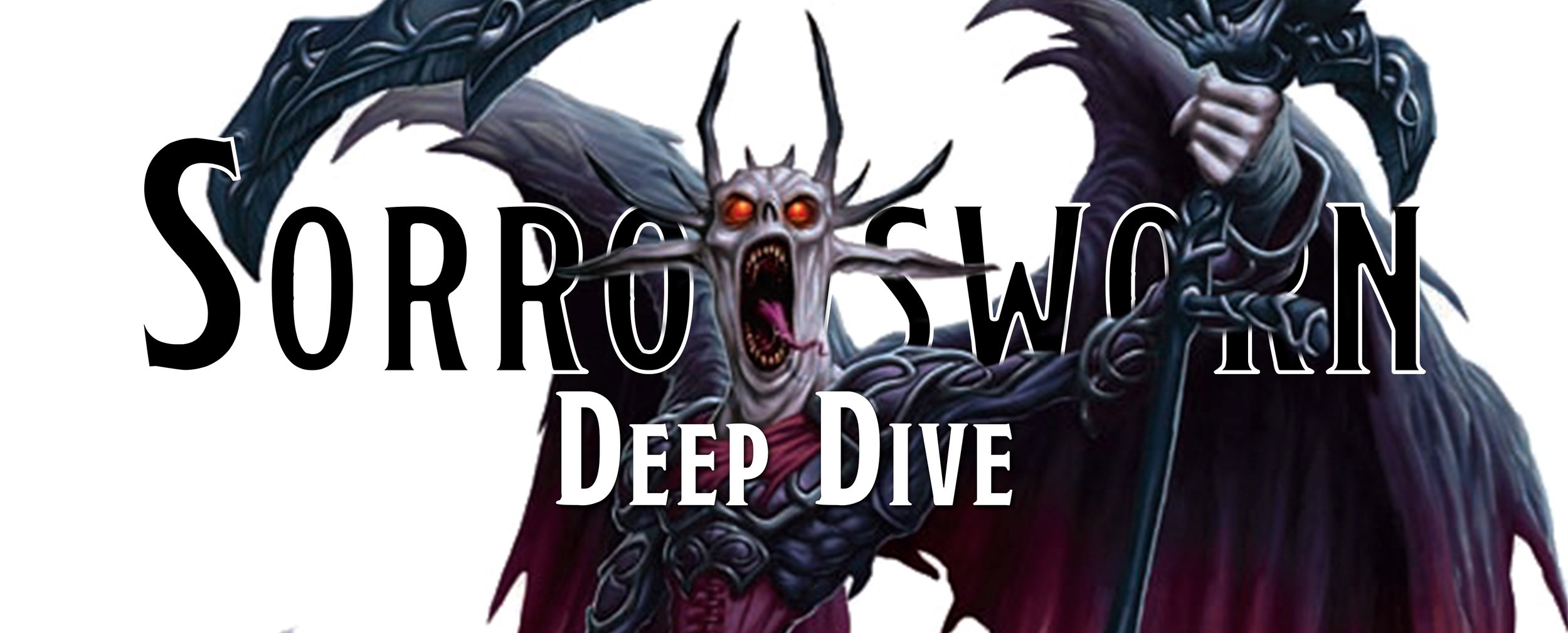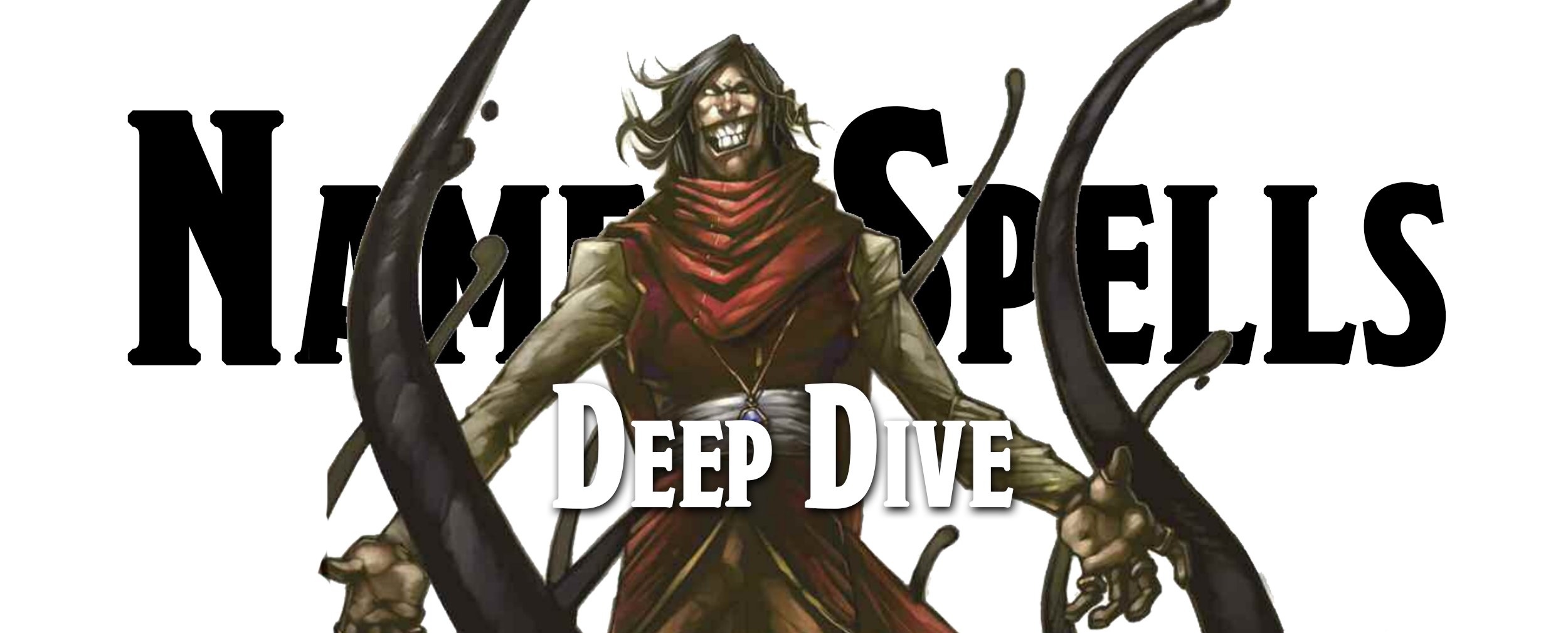Deep Dive - The Wight
The Wight is a dangerous undead with a penchant for making friends out of their enemies. While this would be comendable in most situations, a Wight goes about this process by literally sucking the life out of you and killing you. While this is a horrible way to start a friendship, you come back to unlife and immediately attack your old friends.
Friendship ended with adventurers. Now Wight is my best friend.
Magic the Gathering, 2021 Wizards of the Coast / Slawomir Maniak
OD&D - Wight
No. Appearing: 2-24
Armor Class: 5
Move: 9
Hit Dice: 3
% in Lair: 50%
No. of Attacks: 1
Damage/Attack: energy drain only
Treasure: B
Found in the White Box: Book II, Monsters & Treasure (1974), the Wight is way more powerful than it lets on. First, the number you encounter at any given time is 2d12, so if the Game Master rolls well, you could face up to 24 of them. At a single time. A half dozen of the creature would be bad enough, but two dozen? You should consider running away if that's the case. Of course, why would you run away from the Wight?
The Wight's Armor Class is 5, which means it is going to be easy to hit them, so that’s pretty good. Unfortunately, your basic attacks just aren’t going to do anything to them. Non-magical weapons are futile against the Wight, and so you need to use whatever magical weapons you’ve been able to find like that single +1 dagger the GM generously provided in the last three dungeons. If you are in a tight spot, silver-tipped arrows will also hurt them, so you better start smelting your hard-earned silver, and hope that the Wights are willing to wait for you to finish your art project.
Things get complicated and quite deadly when we discuss their attacks. A Wight hitting you isn't going to reduce your hit points. Don't get excited because what it does is much worse. For every successful hit, the Wight drains you of a life energy level. This means your character drops a level, and, more importantly, loses everything that comes with the corresponding level: hit dice, attack bonuses, etc. So in a way, you do lose hit points, but so much more too.
If the Wight drains you of all your life energy, you die. Luckily, death is temporary because not too long after, you’ll be back as a Wight… just in time for Halloween.
Basic D&D - Wight (Moldvay)
Armor Class: 5
Hit Dice: 3*
Move: 90’ (30’)
Attacks: 1
Damage: Energy drain
No. Appearing: 1-6 (1-8)
Save as: Fighter: 3
Morale: 12
Treasure Type: Nil
Alignment: Chaotic
Magic the Gathering, 2021 Wizards of the Coast / Phil Stone
The Wight appears in the Holmes Basic Set (1977), Moldvay Basic Box Set (1981), and Mentzer Basic Rules Box Set (1983). There's not much difference between the three of them, nor from the original incarnation. Of interest is that Holmes calls the creature Barrow Wights, referencing Tolkien as their source.
Regardless of the edition, the Wight retained its most frightening ability. Being hit by a Wight still sucks the life right out of you, taking with it a hit die. If you are killed by a Wight, you'll return as one. Not only that, but you are under the control of the Wight that killed you. We sure hope you like your new boss!
There are a few variances between the editions. Holmes specifies that silver-tipped arrows and magic weapons do normal damage, and magic arrows do double damage. No mention of silver melee weapons. The other two editions state a Wight can only be hit by silvered or magical weapons. In Mentzer and Moldvay, it takes up to 4 days for you to return as a Wight after it has killed you by draining your entire life force. Holmes doesn't specify a time, so we assume you fall dead, a round passes, and you pop back up as a Wight, because that’s what we’d do as a Game Master.
1e - Wight
Frequency: Uncommon
No. Appearing: 2-16
Armor Class: 5
Move: 12”
Hit Dice: 4 + 3
% in Lair: 70%
Treasure Type: B
No. of Attacks: 1
Damage/Attack: 1-4
Special Attacks: Energy drain
Special Defenses: Silver or magic weapons to hit
Magic Resistance: See below
Intelligence: Average
Alignment: Lawful evil
Size: M
Psionic Ability: Nil
Level/X.P. Value: Nil
Monster Manual, 1977 TSR Inc.
The Wight appears in the Monster Manual (1977) with an opening line stating that the Wight has lost its old meaning, and now is the undead creature we know and love. What was the old meaning of Wight? Apparently, it meant, and still means in the real world, a creature, specifically a human being. We suppose a lot of Wights were once human beings, especially since they can’t help but get themselves killed whenever they go on an adventure.
There are a few minor things we learn about these poor, misunderstood undead. The Wight resides in burrow mounds or catacombs, the usual haunt of undead creepers. They hate the sun, so it makes even more sense in their choice of living spaces. The next tidbit won't come as a surprise, but Wights are evil. Not only that, but they like to kill the living. Shocking, we know. In addition, they are immune to the typical undead things like sleep, charm and hold spells, cold-based spells, and they cannot be poisoned or paralyzed.
The source of many of the Wight's abilities is now explained by the fact that the creature lives simultaneously on both the material plane and Negative Energy Plane. This is why they can only be hurt by magic and silver weapons. There is some good news, however, as you can damage the Wight in some new ways. Smashing a vial of holy water will hurt them. If your Cleric has prepared for this moment their entire life, they will have a raise dead spell ready to go, as it kills the Wight instantly.
Living on two planes at once also explains why they can drain your life energy when they hit you. Their attack now does a d4 of damage, but 2 points of damage is nothing compared to losing an entire experience level, along with all the class abilities, spells, and hit dice that come along with it. Once again, when a Wight sucks away all your life energy, and they definitely will, you come back as a Wight under your killer's control. You're only a half-strength Wight, which we guess is good for the ex-friends you'll be attacking.
2e - Wight
Climate/Terrain: Any land
Frequency: Uncommon
Organization: Solitary
Activity Cycle: Night
Diet: See below
Intelligence: Average (8-10)
Treasure: B
Alignment: Lawful evil
No. Appearing: 2-16 (2d8)
Armor Class: 5
Movement: 12
Hit Dice: 4+3
THAC0: 15
No. of Attacks: 1
Damage/Attack: 1-4
Special Attacks: Energy drain
Special Defenses: Hit onyl by silver or +1 or better magical weapon
Magic Resistance: See below
Size: M (4’-7’)
Morale: Elite (14)
XP Value: 1,400
Monstrous Compendium Vol 1, 1989 TSR Inc.
The Wight appears in the Monstrous Compendium Vol. 1 (1989) and Monstrous Manual (1993), and while only a few changes are made, we are given more interesting facts about the creature. When you're out in the darkness and see a humanoid-like creature walking towards you, be wary, especially if you’re near burrow mounds or catacombs. If the terrain you are on has no vegetation of any sort, that's another sign of danger. A Wight's presence will kill all the plant life in its vicinity. Lastly, while they still hate the sunlight, it won't hurt them. So no longer are you safe during the day.
Once you get up close to them, you'll realize they are a Wight, but it will be too late by then. They resemble the creatures they once were, but now their skin is mummified, their eyes burn within their sockets, and their hands are razor-sharp claws. Kind of how we look like when we wake up.
Monstrous Manual, 1993 TSR Inc.
Their main motivation is to kill you as they hate all living things and will kill any they encounter, so it’s not just you. Since this is the case, we recommend listening to your dog, cat, or whatever other pet you may have traveling with you. They can sense the otherworldly presence of the Wight and will bark, growl, or emit whatever sound they make in warning, and may even abandon you when you are foolish enough to still walk into the catacombs.
It's not just a single Wight you'll be fighting, either. Even though they prefer to hang out alone, Wights will be found in groups of up to 16. The group will have a boss Wight, but this leader is not any more substantial than the others, and we assume they’re just the most charismatic of the bunch. The leader will, however, be willing to let some lesser Wights fight the good fight and die if it means it can feast on your life force or run away if things aren't going well.
Dragon #198 (October 1993) introduces the King-Wight in the article Beyond the Grave by Tom Moldvay. The article also discusses the lore of the creature, first diving into the creature's history, some of which we already know. There was such a thing as a good Wight, known as a Seelie Wight, as depicted in Robert Chambers' book Popular Rhymes of Scotland. Of course, over time, the term Wight came to mean old evil Wights that we know today, and Moldvay references Tolkien's Barrow Wight as an example.
Dragon #198, Oct. 1998 TSR Inc. / Tom Baxa
The King-Wight is a powerful king who died and has the unfortunate luck of returning as a Wight. These creatures appear about as close to human as a Wight can hope for but still smells of rotten flesh. That's always a dead giveaway that you're dealing with some sort of undead creature. Still, it's good to be king, as they keep their fancy jewels, weapons, and armor. They also keep their court, but these poor chaps are turned into Wights under the King-Wight's control. In addition, they enjoy messing with the living cause what we need is a trickster undead. A King-Wight may say they are your friend, inviting you to their home for a nice meal. The reality is they want to kill you or turn you into one more member of their entourage of Wights.
Slaying a King-Wight is no easy task. That fancy armor we mentioned above turns out to be +3 chain mail and they wield a +2 sword. King-Wights drain 2 life energy levels out of you per hit, not just the single level of those commoner Wights. You do get a save when you get hit, though, so there is good news. Of course the save has nothing to do with your lost levels, just that if you are a lower level than the Wight, failing a save means you run away, screaming like a fear spell was cast.
Frost Wight / Dragon #246, April 1998 TSR Inc. / George Vrbanic
Another issue of Dragon, Dragon #246 (April 1998), introduces us to two new Wights, The Frost Wight and the Shadow Wight. Both creatures fall under the category of Chaos Wights. These Wights, along with several other creatures, are from the world of Krynn in the Dragonlance setting. After the Chaos War, they were spawned from the Abyss when Chaos was released. They are the remnants of fallen knights raised from the dead by Chaos.
Neither of the Wights has a humanoid form. The Frost Wight appears as a human-sized mini blizzard consisting of swirling snow and wind. The Shadow Wight is a mix of black clouds or shadows. Neat fact about the Shadow Wight, they are 'living holes in the fabric of reality’. We're not sure what that means for brave adventurers, but it sounds scary.
Shadow Wight / Dragon #246, April 1998 TSR Inc. / George Vrbanic
When you get close enough to hit either of these Wights with your sword, they will transform into a copy of you and whisper sweet nothings into your ear. Well, sweet nothings being hypnotic words of hopelessness. These words will cause you such despair that a failed saving throw has horrifying effects. The next time the Wight touches you, you literally blink out of existence. Not only that, but even your closest friends forget you as your existence is wiped from the memories of everyone you know.
These Wights have a few unique features. The Frost Wight is immune to cold attacks. An ordinary weapon can hit either of Wights if it has been blessed. When a metal weapon kills a Frost Wight, it freezes and shatters on its next strike, but at least your magic weapons get to make a saving throw. Fire does double damage to the Frost Wight, and the presence of any small fire, including candles, prevents them from transforming into a replica of you. Shadow Wights are susceptible to light-based spells such as light and faerie fire, and they also prevent the shadow wights from taking the shape of an intended victim.
Both Wights live in cold regions and hang out with other creatures created by the Chaos. Such places may be depressing and lonely, but they don't mind because they have their friends. Like their normal Wight cousins, they live to destroy all life, and their special ability makes it even easier. We're confident they enjoy scouring the countryside for creatures they can use their nullification powers on, making these lands even lonelier.
The Wailing Wight appears in Dragon #249 (July 1998) and the module Return to the Tomb of Horrors (1998) by Bruce Cordell. Going once was bad enough, but returning to the Tomb of Horrors is downright foolish. Anyways, the Wailing Wight. Created by priests of Acererak, the Wailing Wight combines the powers of the Wight and the banshee. In the adventure, they wander around the Undertomb, screaming their heads off and trying to drain the essence of life out of you. A Waling Wight's Touch causes a permanent energy drain as an average wight. In contrast, their scream causes only a temporary energy drain. Of course, we say ‘only’ because we're giving you the benefit of the doubt by thinking you'll be able to kill the creatures or run away as fast as you can.
Dragon #348, Oct. 2006 Paizo Inc. / Peter Bergting
The Barrier Wight, found in Dragon #261 (July 1999), is unlike any other Wight we've encountered. The Barrier Wight is based on the creature found in the computer game Myth: The Fallen Lords by Bungie. They are created and under the control of the Fallen Lords. The unintelligent, bloated monsters are made of vessels containing a whole lot of pus or poisonous gas. There are even a lucky few that are filled with both.
Used as guards, they defend whatever they are told to by cutting themselves and exploding if you get too near. That's right, they explode, their pus and gas-filled bodies splattering all over you and your friends. The explosive damage is minor, especially compared to the goo or gas now covering your body. The pus will give a disease that siphons off half your hit points for every day it is untreated. If you are enveloped in the gas, you'll be paralyzed for up to four rounds, which is plenty of time for other nearby creatures to kill you.
3e - Wight
Medium Undead
Hit Dice: 4d12 (26)
Initiative: +1
Speed: 30 ft. (6 squares)
Armor Class: Class: 15 (+1 Dex, +4 natural), touch 11, flat-footed 14
Base Attack/Grapple: +2/+3
Attack: Slam +3 melee (1d4+1 plus energy drain)
Full Attack: Slam +3 melee (1d4+1 plus energy drain)
Space/Reach: 5 ft./5 ft.
Special Attacks: Create spawn, energy drain
Special Qualities: Darkvision 60 ft., undead traits
Saves: Fort +1, Ref +2, Will +5
Abilities: Str 12, Dex 12, Con —, Int 11, Wis 13, Cha 15
Skills: Hide +8, Listen +10, Move Silently +16, Spot +10
Feats: Alertness, Blind-Fight
Climate/Terrain: Any
Organization: Solitary, pair, gang (3–5), or pack (6-11)
Challenge Rating: 3hat
Treasure: None
Alignment: Always lawful evil
Advancement: 5-8 HD (Medium)
Level Adjustment: —
Monster Manual, 2003 Wizards of the Coast / Wayne Reynolds
There is precious little information about the Wight, located in the Monster Manual (2000) and later reprinted in the Monster Manual (2003). Undead creatures, who hate life? Yep. Live in barrow mounds and other other dark and depressing locations? Sure thing. Energy drain on an attack? You bet. Are you becoming a Wight after it sucks the life out of your body? Of course. So, is there anything new?
Well, there's a tiny bit. The creature now resembles the person they were in life. Of course, being dead and filled with hatred will make you look like a very angry caricature of your former self. When the Wight drains you, you take a negative level, which is way better than losing a whole experience level, even though you still take penalties as if you lost a level, it’s just not super permanent. On the downside, your life force gives the Wight 5 temporary hit points.
Dust Wight / Monster Manual III, 2003 Wizards of the Coast
In the Monster Manual III (2003), we find the Dust Wight. They appear as vaguely humanoid creatures similar to an earth elemental. They weigh in at a hefty 400 pounds and are surrounded by a cloud of dust. This dust is the source of the Dust Wights' Petrifying Cloud ability. It does just what the name implies. If you come into contact with the dust and make your save, you are petrified the next round. The Dust Wight will then pummel you with its giant fists, intending to turn you into a pile of broken stone.
This aggressive need to shatter your new stone body comes from its desire to destroy everything created from stone or metal. It's similar to their Wight relatives who hate all living creatures and attack them on sight, but really–it’s their fault for turning you to stone! If you happen to be in armor, let’s say plate mail, the Dust Wight doesn't mind killing you to destroy it. It accomplishes this through its Crumbling Touch ability. On a successful slam attack, any metal or stone structure or object is damaged. When the object is destroyed, the Wight gains 5 temporary hit points. We're sure this is the one time the wizard hiding in the back is happy about being unable to wear armor.
The Epic Level Handbook (2002) has the Perfect Wight, an archetype available to only the highest-level thieves and assassins of incredible skill and prowess. They aren't a Wight, but characters that can go Incorporeal and assume Shadow form.
Lavawight / Epic Level Handbook, 2002 Wizards of the Coast
As for actual Wights, there is the Lavawight. Created by those who died by fire, they are made from and hardened by the flames like the ones that killed them. They permanently drain your hit points through Blazefire, by setting you on fire. The Winterwights are skeletons wrapped in hard ice, created by a powerful demi-lich who thought it should see just how far they could push their necromancy. Their special ability is almost identical to the Lavawight’s Blazefire, except you are encased in a dark black flame that kills you.
Dragon #300 (October 2002) provides a template for creating a Wight character. Such a template can be added to any creature except oozes, constructs, or other undead. Thank goodness; no more Wight/Banshee combos. There's not much to see here, but know that this grants the new creature its previous abilities and its newfound powers of energy drain, creating spawn when it kills you.
The Vilewright graces the pages of the Book of Vile Darkness (2002). They aren't precisely Wights, so let's say they are Wight adjacent. They look like Wights if you don't consider that their intestines extend out of the stomach and are used as limbs. Limbs that can bite you, which they most certainly do if you are grappled by the creature with its Improved Grab Attack.
Vilewight / Book of Vile Darkness, 2002 Wizards of the Coast
Of course, the Vilewight has other ways to send you to an early grave. Along with its claw attack, the Vilewight will bite you with its hideous, sharp teeth. The Vilewight's Dark Channel attack allows it to form a 30-foot-long line of cold black energy out of negative energy. If one of the tendrils manages to bite you when you're in its grasp, you may contract the disease life blindness after 1 day. It doesn't hurt, but you cannot see all living creatures until the disease is removed.
Last but not least, the Vilewight has an Energy Drain attack. The Vilewight's drain attack gives its victim two negative energy levels, and each level grants the undead creature 5 temporary hit points. And what would a Wight creature be without the ability to make you into a Wight after it kills you? Well, it would be no Wight at all, so this is precisely what happens when a Vilewright sends you over the rainbow bridge.
What would Libris Mortis: the Book of Undead (2004) be without the Wight? Incomplete, of course! The book brings us the Slaughter Wight, which is an awesome name. These Wights have been touched by the Dark Gods, so if you didn't think it was possible for something to hate life more than a normal Wight, you'd be wrong. Often hired as assassins, the Slaughter Wight roams the city streets at night, hunting and killing its intended target, and probably tons of other bystanders just trying to have a relaxing evening.
Slaughter Wight / Libris Mortis: the Book of Undead, 2004 Wizards of the Coast
It slaughters quite efficiently through several means. A Slaughter Wight's slam attack is more powerful than we've seen in most other Wights due to its Vicious Slammer special quality. When coupled with its Improved Critical, the Slaughter Wight's Augmented Critical quality increases the threat range of its slam attack. Targets of its Energy Drain attack gain one negative energy level. It constantly needs to drain your life force due to its Inescapable Craving trait. And, of course, when you die at the hands of a Slaughter Wight, you return as a Wight in 1 to 4 rounds.
Lastly, Dragon #348 (Oct. 2006) does a long overdue Ecology of article on the Wight. We know most of the information on the pages, but they are presented in more detail. Did you know that their claws are just really long fingernails? Now you do, and it’s gross. In addition, Wights think of us living folk as nothing more than cattle to be slaughtered. The lair of the Wight is nowhere close to where a living creature would want to live, and it’s not just because there are Wights in the area. They like small, cramp dwellings with probably lots of cobwebs, corpses, and terrible smells of death.
Dragon #348, Oct. 2006 Paizo Inc. / Peter Bergting
4e - Wight
Level 5 Skirmisher
Medium natural humanoid (undead) / XP 200
Initiative +7
Senses Perception +0; darkvision
Immune disease, poison
Resist 10 necrotic
Vulnerable 5 radiant
HP 62; Bloodied 31
AC 19 Fortitude 18, Reflex 17, Will 16
Speed 7
Claw (standard; at-will) ✦ Necrotic +10 vs. AC; 1d6 + 4 necrotic damage, the target loses 1 healing surge, and the wight shifts 3 squares.
Skills Stealth +10
Alignment Evil
Languages Common
Str 18 (+6) Dex 16 (+5) Wis 6 (+0) Con 14 (+4) Int 10 (+2) Cha 15 (+4)
The Monster Manual (2008) blesses us with a slew of Wights, some old, some new, some borrowed, some blue. What's unfortunate is none of them are given much of a description. At least we do get a lot of them with the Wight, Deathlock Wight, Battle Wight, Battle Wight Commander, and Slaughter Wight. In general, Wights still hate the living and will attack them on sight, draining them of their life force.
Monster Manual, 2008 Wizards of the Coast / David Griffith
Thanks to their predication for living in dark and gloomy places, such as tombs and catacombs, most adventurers should know enough to not disturb them. What's different about these Wights is that they usually have a boss, typically a powerful undead creature. We aren't sure whether they are unionized, but they don't seem to mind this arrangement. Also, Wights have what's considered a hoard of goodies they amassed from those they killed. It may not be anywhere as big, but this hoard is probably more accessible to obtain than, let's say, a dragon's.
The Deathlock Wight is the least powerful of the Wights, although it has more attacks and abilities than the normal Wight. The Wight is more of a footsoldier, charging in first and clawing through those before them. The Deathlock Wight can also claw but generally uses its Horrific Visage to keep you far away, so it can use a grave bolt attack to immobilize you. Once it kills you, the Deathlock Wight will bring you back with its Reanimate ability to reunite you with your friends… so that you can kill them.
A Battle Wight and Battle Wight Commander are the next two Wights regarding strength and power. With the Battle Wight, we have our first Wight that wields a weapon, a nasty, soul-draining longsword. It doesn't do much in terms of the actual damage, but when hit, the target loses a healing surge and becomes immobilized. Once that happens, the Battle Wight will use its Soul-Reaping ability, inflicting necrotic damage and healing itself. The Battle Wight Commander has a similar longsword, which does a bit more damage, inflicts you with the weakened trait, and immobilizes you. The Commander's follow-up attack is Soul Harvest, a more powerful version of the Battle Wight's soul reaping. The necrotic damage is nothing compared to the mass heal it does for all undead friends within range.
Lastly, there is the Slaughter Wight. This isn't your 3rd edition Slaughter Wight, but it's no less deadly. The most powerful of the Wights, the Slaughter Wight's hit points and armor class alone make it difficult to deal with. It loves to claw its way through the living targets in front of it. Once it kills you, one of your friends, or just some poor, random person who got in its way, the Slaughter Wight will let loose its Death Wail. This burst hits everyone, including the other undead. However, they get an advantage in preventing the necrotic damage they could take. You, on the other hand, aren't so lucky.
Ashgaunt / Dragon #364, June 2008 Wizards of the Coast / Dave Allsop
Quickly looking at the dragon hoard of Wights in this edition, we begin with Dragon #364 (June 2008) which presents the Ashgaunt, who has many of the Wight's traits, including Life Drain, but isn't named a Wight. Dungeon #159 (October 2008) has the Betrayer Wight, a Slaughter Wight, but by a different name. Dungeon #163 (Feb. 2009) presents the Battle Wight Bodyguard, a Battle Wight between the other two Battle Wights in terms of power. In addition to its longsword and soul-reaping attacks, it also can mark an opponent with its Indomitable Presence, allowing it to attack a creature immediately when the target attacks an ally.
We hoped that the sourcebook Open Grave - Secrets of the Undead (2009) would have something to add about the Wight, but it doesn't have much. Even though we assumed as much, it's clearly stated that the Wight is a soulless creature. You can graft a Wight's Claw onto a creature, and while it won't drain someone's life force, it will remove a healing surge. In the Dungeon Master's Guide 2 (2009), there is the Wight Life Eater, a basic Wight whose claw attack allows the Wight to shift and drains a target's healing surge.
The Slaughter Wight Rippers are found in the adventure Kingdom of the Ghouls (2009). They are slightly more powerful than the regular old Slaughter Wight, probably why they get to append “Rippers” to their name. The Prince of Undeath (2009) has the Slaughter Wight Overlord. It's a more powerful version of the Slaughter Wight, who also has the Bloodied Burst attack. This allows the Overlord to push targets back while inflicting necrotic damage. It does seem like Wights like to append epithets to their names the stronger they get.
The Dark Sun setting didn't want to be left out, so you can find the Wight Thrall in the Dark Sun Creature Catalog (2010). If you're a servant, valued court member, or advisor to a powerful leader who's been turned into a Wight, you follow them into death as a Wight Thrall. There's only a little to see here besides a claw attack and its Dark Passing ability. The Thrall grants temporary hit points to other undead around it. Still, unfortunately for them, they have to die for this to happen. It could be a blessing since they will actually be dead.
Wight Thrall / Dark Sun Creature Catalog, 2010 Wizards of the Coast / David Rapoza
Wights are updated in Dungeon #191 (June 2011). It's not much of an update, as all the Wights don't change much. The article provides more information on the Wight and its abilities. Detailed and unnerving, the description of the Life-Draining Touch will make you re-evaluate getting close enough for them to touch you. We're given a tour of a Wight's home, and if you live nearby, your property values will plummet, probably due to the Wights but we aren’t sure. Still need to do a property assessment.
We find out where they land in the hierarchy of undead when serving undead masters and find out just how greedy and guarded they are with their treasure. We also are told how former soldiers make great Wights, knowing how to fight tactically through maintaining the order and hierarchy they had in life.
5e - Wight
Medium Undead, neutral evil
Armor Class 14 (studded leather)
Hit Points 45 (6d8 + 18)
Speed 30 ft.
STR 15 (+2) DEX 14 (+2) CON 16 (+3) INT 10 (+0) WIS 13 (+1) CHA 15 (+2)
Skills Perception +3, Stealth +4
Damage Resistances necrotic; bludgeoning, piercing, and slashing from nonmagical attacks not made with silvered weapons
Damage Immunities poison
Condition Immunities exhaustion, poisoned
Senses Darkvision 60 ft., Passive Perception 13
Languages the same languages it knew in life
Challenge 3 (700 XP); Proficiency Bonus +2
Sunlight Sensitivity. While in sunlight, the wight has disadvantage on attack rolls, as well as on Wisdom (Perception) checks that rely on sight.
Multiattack. The wight makes two longsword attacks or two longbow attacks. It can use its Life Drain in place of one longsword attack.
Life Drain. Melee Weapon Attack: +4 to hit, reach 5 ft., one creature. Hit: 5 (1d6 + 2) necrotic damage. The target must succeed on a DC 13 Constitution saving throw or its hit point maximum is reduced by an amount equal to the damage taken. This reduction lasts until the target finishes a long rest. The target dies if this effect reduces its hit point maximum to 0. A humanoid slain by this attack rises 24 hours later as a zombie under the wight's control, unless the humanoid is restored to life or its body is destroyed. The wight can have no more than twelve zombies under its control at one time.
Longsword. Melee Weapon Attack: +4 to hit, reach 5 ft., one target. Hit: 6 (1d8 + 2) slashing damage, or 7 (1d10 + 2) slashing damage if used with two hands.
Longbow. Ranged Weapon Attack: +4 to hit, range 150/600 ft., one target. Hit: 6 (1d8 + 2) piercing damage.
Monster Manual, 2014 Wizards of the Coast
The Wight graces the pages of the Monster Manual (2014). A Wight is created when a particularly evil and vain individual dies, and it is brought back by a dark lord to spend eternity killing the living. They spend their time as independent entities but serve the evil creatures that return them to the land of the living. Life Drain is still the scariest thing about the Wight. They are now afflicted with Sunlight sensitivity, making their dark and gloomy residence in a tomb, catacomb, or barrow mound even more vital to them.
What really sucks about this Wight is if, we mean, when it kills you, you don't even get to come back as a Wight. Now you're an ordinary zombie, shuffling around looking for brains to eat. You're under the control of the Wight that killed you, and we're willing to bet you'll serve as nothing more than a meat shield. This way, the Wight can get to your friends and make them into zombies. You can take some solace in the knowledge you won't be alone.
In Dead in Thay (2014), and reprinted in Mordenkainen Presents: Monsters of the Multiverse (2021), we are given the Deathlock Wight. It’s what happens when a warlock decides to grow a conscience and break off their pact with their patron. The consequence of doing so could include dying, probably horrifically, and then being brought back as an undead forced or driven to serve its patron in death.
They have the normal abilities of a Wight, but can also shoot bolts of necrotic energy, cast a handful of spells to terrify their opponents, and drain the life force of humanoids. If you die, you get to be a zombie searching for brains, which is probably still a better outcome than breaking a pact with your patron.
Mordenkainen Presents: Monsters of the Multiverse, 2021 Wizards of the Coast
Whether you're skulking around dark and gloomy catacombs or hanging out at random barrow mounds, you should be on the lookout for the Wight. It's one thing to be drained from a long day of adventuring and another to be drained of your life force forever. Has the Wight gotten less dangerous over the editions, watered down like so many other creatures? No, unless you consider coming back as a zombie a huge downgrade rather than being reanimated as a Wight.
If you enjoy our Deep Dive series, consider
supporting us on Patreon
and following us on Facebook and Instagram!


